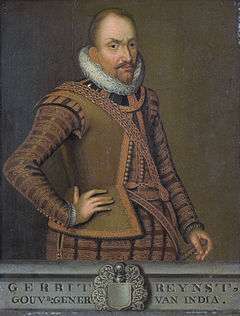Samuel Blommaert
| New Netherland series |
|---|
| Exploration |
| Fortifications: |
| Settlements: |
| The Patroon System |
|
| People of New Netherland |
| Flushing Remonstrance |
 |
Samuel Blommaert (Bloemaert, Blommaerts, Blommaart, Blomert, etc.) (11 or 21 August 1583 in Antwerp – 23 December 1651 in Amsterdam[1] ) was a Flemish/Dutch merchant and director of the Dutch West India Company from 1622 to 1629 and again from 1636 to 1642. In the latter period he was a paid commissioner of Sweden in the Netherlands and he played a dubious but key role in Pierre Minuit's expedition that led to the Swedish colonizing of New Sweden. In 1645 he was appointed for a third time as a manager of the WIC, being one of the main investors from the beginning.
Early life
Samuel was born in Antwerp, capital of the Antwerp province in Flanders, one of Belgium's three regions. He was the son of Margaretha Hoefnagel [2] and the wealthy merchant Lodewijk Blommaert (1537–1591),[3] who in 1581 was schepen of Antwerp and in 1583 captain at Fort Lillo on the eastern border of the Scheldt. Margaretha died when Samuel was young and his father moved the family to London, when Antwerp was occupied in 1585 by the Duke of Parma. He remarried but died in 1591. Samuel was apprenticed in Stade, The Hague, and Vienna. In 1602 he visited Benin.[4][5] In 1603, Samuel enlisted with the Dutch East India Company and traveled to the Dutch East Indies on a ship under admiral Steven van der Hagen. In the years 1605–1606 he stayed on Borneo. In 1607 he was sent by the board to Sukadana West Kalimantan to rescue Hans Roeff, who had died when Blommaert arrived. He returned to Bantam with 633 diamonds.[6] In 1609/1610 he again stayed on Sambas, Borneo. In September 1610 he left sooner than expected for Texel and arrived in June 1611. Pieter Both had to investigate the case.
He settled in Amsterdam, where he became a prominent merchant. On 5 June 1612, he married Catharina Reynst, a daughter of Gerard Reynst, with whom he would have 12 children between 1613 and 1633, each born in Amsterdam. His daughter Constantia (1626-) married the admiral Isaac Sweers.[7][8]
Early career

Blommaert was involved in a company which traded on Angola, together with Frans Jacobsz. Hinlopen, and Lucas van der Venne.[9][10] In 1615 Jacob le Maire carried a letter from his father to be presented to Governor Reynst, with an offer to carry (smuggle) goods to his son-in-law Samuel Blommaert in Amsterdam. Blommaert was investigated in Amsterdam by the board of the East-India Company on January 30, 1616 [11] about a vessel, named Mauritius de Nassau, sailed from a Dutch port, under the command of Jan Remmetszoon, of Purmerend. The ship was ostensibly destined for Angola, but from there she was ordered to direct her course for "Terra Australe, called Terra del Fuego." The plan, therefore, was, from the west coast of Africa to sail southward, until the supposed South-land should have been reached, and then "to explore the whole of the coast of Terra Australi as far as the Straits of Magellanes, on the chance of finding an opening that might allow a passage to the South-sea; and on such opening being found, to run into and through the same, in order to discover whether they could in such manner get into the South-sea; should such passage to the South-sea have been found, they had orders to return home forthwith, but in case adverse circumstances should prevent them from doing so, they were to run on for the East Indies."[12]
After November 1620 he settled on Keizersgracht with a view on Westerkerk. He told one of his neighbors, professor Nicolaes Tulp, stories on bestiality he heard on Borneo.[13]
New Netherlands

By 1622, he had become one of the directors of the Amsterdam chamber of the recently founded Dutch West India Company. For years Blommaert was involved in the copper trade and industry. In 1627 he had an argument about a cargo of 34 Swedish guns.[14] In 1628 he collaborated with Kiliaen van Rensselaer, Samuel Godijn en Albert Coenraetsz. Burgh.[15] In company with Godyn, a fellow-director, he bargained with the natives for a tract of land reaching from Cape Henlopen to the mouth of the Delaware River.[16] This was in 1629, three years before the charter of Maryland, and is the oldest deed for land in the state of Delaware. Its water-front nearly coincides with the coast of Kent and Sussex coast. The purchase was ratified in 1630 by Peter Minuit and his council at Fort Amsterdam.[17]
A company was formed to colonize the tract that included Blommaert, Godyn, Kiliaen van Rensselaer (Patroon of Rensselaerswyck), Joannes de Laet (the geographer), and David Pietersen de Vries. A ship of eighteen guns was fitted out to bring over the colonists and subsequently defend the coast, with incidental whale-fishing to help defray expenses. A colony of more than thirty souls was planted on Lewes creek, a little north of Cape Henlopen, and its governorship was entrusted to Gillis Hosset. This settlement antedated by several years any in Pennsylvania, and the colony at Lewes practically laid the foundation and defined the singularly limited area of the state of Delaware, the major part of which was included in the purchase. A palisaded fort was built, with the "red lion, rampant," of Holland affixed to its gate, and the country was named Swaanendael or Zwaanendael Colony, while the water was called Godyn's Bay now known as Delaware Bay. The estate was further extended, on May 5, 1630, by the purchase of a tract twelve miles square on the coast of Cape May opposite, and the transaction was duly attested at Fort Amsterdam.
The existence of the little colony was short, for the Indians came down upon it in revenge for an arbitrary act on the part of Hosset, and it was destroyed, not a soul escaping to tell the tale. According to acknowledged precedent, occupancy of the wilderness served to perfect title; but before the Dutch could reoccupy the desolated site at Lewes, the English were practically in possession.[18]
New Sweden
In 1635, he started a brass factory in Nacka, outside Stockholm. Swedish chancellor Count Axel Oxenstierna subsequently visited Holland. Soon after he left, Blommaert started to send letters to the Swedish chancellor. In 1636, Blommaert became the consul for Sweden in Amsterdam.[19] Blommaert secretly assisted with the fitting out of the first Swedish expedition with Fogel Grip and Kalmar Nyckel to New Sweden in 1637 and engaged Peter Minuit to command it. When two expeditions turned out to be unprofitable for Blommaert, he withdrew. In those years, Blommaert was so heavily interested in seizing Spanish ships, which sailed from the Caribbean loaded with silver, to make the New Sweden colonization more successful.
Blommaert's thirty-eight letters to the Swedish chancellor Count Axel Oxenstierna, from 1635 to 1641 are of great importance to the history of New Sweden. These letters were published in Repertorium Veterrimarum Societatum Litterariarum 1870–1879 of the Utrecht Historical Society and in Bijdragen en Mededeelingen (1908).[20]
References
- ↑ Samuel Bloemert was buried in the Westerkerk in 1651
- ↑ Constantijn Huygens was his cousin.
- ↑ http://www.genealogieonline.nl/genealogie-peeters-rouneau/I4825.php
- ↑ His account, given to Isaac Vossius was used by Olfert Dapper in 1668.
- ↑ http://africanistes.revues.org/document125.html#ftn27
- ↑ http://databases.tanap.net/ead/html/1.04.02/index.html?N1437B
- ↑ Genealogie van Isaak Sweers, (H. de Voogd v.d. Straaten De Nederlandsche Leeuw, No.9 (1893), pp. 65–7) (in Dutch)
- ↑ Birth certificates of twelve children; Lodewijk (1613), Jacques (1617) and Cathrina (1624) died in their infancy
- ↑ Klein, P.W. (1963) De Trippen in de 17e eeuw, p. 146.
- ↑ Gelderblom, O. (2000) Zuid-Nederlandse kooplieden en de opkomst van de Amsterdamse stapelmarkt, pp. 224, 231.
- ↑ Kernkamp, G.W. (1908) Brieven van Samuel Blommaert aan den Zweedschen Rijkskanselier Axel Oxenstierna 1635–1641, pp. 16–17. In: Bijdragen & Mededeelingen van het Historisch Genootschap, nr. 29.
- ↑ http://gutenberg.net.au/ebooks06/0600571h.html
- ↑ Dearest pet: on bestiality Door Midas Dekkers,Paul Vincent
- ↑ Klein, P.W. (1963) De Trippen in de 17e eeuw, p. 279.
- ↑ http://www.nationaalarchief.nl/transcripties/blommaert_index.html
- ↑ http://www.hetverhalenarchief.nl/image/59
- ↑ The First Settlers ( Delaware Living History) http://www.delawareliving.com/history.html
- ↑ Isaack de Rasieres to Samuel Blommaert 1628 (Caleb Johnson. MayflowerHistory.com) http://www.mayflowerhistory.com/PrimarySources/IsaacRasieresLetters.pdf
- ↑ Klein, P.W. (1963) De Trippen in de 17e eeuw, p. 374.
- ↑ Journal-Title Abbreviations in Old Journals in the Repertorium Veterrimarum Societatum Litterariarum 1870–1879 http://www.scholarly-societies.org/history/AbbrevsInOldJournals1870_1879.html
Primary Source
- Jameson, J.F. editor. Narrative of New Netherland 1609–1664 (Project Gutenberg – from the series: Original narratives of early American history. Original Printing 1909)
![]() This article incorporates text from a publication now in the public domain: Wilson, James Grant; Fiske, John, eds. (1891). "article name needed". Appletons' Cyclopædia of American Biography. New York: D. Appleton.
This article incorporates text from a publication now in the public domain: Wilson, James Grant; Fiske, John, eds. (1891). "article name needed". Appletons' Cyclopædia of American Biography. New York: D. Appleton.